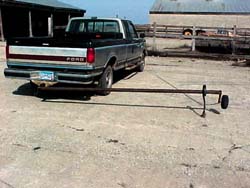
Global Positioning Systems can lay arrow-straight paths across fields, but they also lay a path to your bank account. Bruce Wichmann, a Fairfax, Minn., farmer found a less technical and less expensive way to lay out perfectly straight rows.
Wichmann farms in south central Minnesota, a land of flat black fields that seem to go on for miles. He and his neighbors have, wherever possible, eliminated fence rows. Starting a field with straight rows is tough enough when you have a field edge to go by, but in Wichmann's country, it's even tougher. "When I was making that first shot across the field, I was always turning around, checking the rear and then getting off line. With my pick-up mounted starter marker, I just take aim at a distant fence post and head straight across the field," says Winchmann.
The row marker unit is simplicity at its finest. Wichmann simply cut a length of 1 1/2-in. sq. tubing to run from his pickup hitch to a point just beyond the 13 ft. mark, on about half the width of the planter. Wichmann mounted a single Danish tooth at the end of the marker to form the row mark. A used 6-in. lawn mower wheel mounts at the end of the tubing to become both a depth gauge and a carrier for the Danish tooth. Chain runs from the end of the marker to a hook on the front bumper of the pickup.
When Wichmann is ready to start planting a field, he simply extends the marker and hangs his head out the window to sight on the far corner of the field. The Danish tooth cuts a furrow 6-in. deep, straight and true to the other end of the field, for the planter operator to follow. No more zigs or zags to smooth out during successive passes.
"It's easier to make a straight mark with the pickup because you're only doing one thing. Then when you're planting, you don't have to sight to the end," says Wichmann. "All you have to do is follow the planter mark." Having straight and uniform rows is especially important to Wichmann. After updating his combine to a 6-row 30-in. header, he converted an 8-row 36-in. 7000 into a 10-row 30-in. wide planter. The combination requires uniformity, but the cost savings were impressive compared to buying a new narrow 12-row planter.
"I readjusted wheel spacing, hung on two new planter units with disk openers for fertilizer and four new hydraulic hoses," recalls Wichmann. "I also converted an 8-row double ganged cultivator to a 10-row single gang unit. Converting from 36 to 30-in. cost me little compared to buying a used 12-row in decent shape. I just have to stay straighter on my planting."
